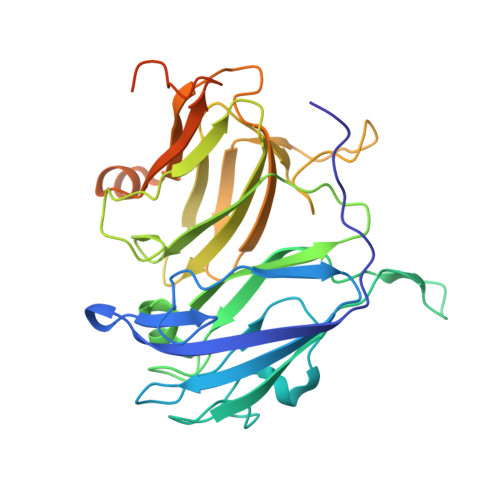Roles of small laccases from Streptomyces in lignin degradation.
Majumdar, S., Lukk, T., Solbiati, J.O., Bauer, S., Nair, S.K., Cronan, J.E., Gerlt, J.A.(2014) Biochemistry 53: 4047-4058
- PubMed: 24870309
- DOI: https://doi.org/10.1021/bi500285t
- Primary Citation of Related Structures:
3T9W, 3TA4, 3TAS, 3TBB, 3TBC - PubMed Abstract:
Laccases (EC 1.10.3.2) are multicopper oxidases that can oxidize a range of substrates, including phenols, aromatic amines, and nonphenolic substrates. To investigate the involvement of the small Streptomyces laccases in lignin degradation, we generated acid-precipitable polymeric lignin obtained in the presence of wild-type Streptomyces coelicolor A3(2) (SCWT) and its laccase-less mutant (SC¦¤LAC) in the presence of Miscanthus x giganteus lignocellulose. The results showed that strain SC¦¤LAC was inefficient in degrading lignin compared to strain SCWT, thereby supporting the importance of laccase for lignin degradation by S. coelicolor A3(2). We also studied the lignin degradation activity of laccases from S. coelicolor A3(2), Streptomyces lividans TK24, Streptomyces viridosporus T7A, and Amycolatopsis sp. 75iv2 using both lignin model compounds and ethanosolv lignin. All four laccases degraded a phenolic model compound (LM-OH) but were able to oxidize a nonphenolic model compound only in the presence of redox mediators. Their activities are highest at pH 8.0 with a low krel/Kapp for LM-OH, suggesting that the enzymes¡¯ natural substrates must be different in shape or chemical nature. Crystal structures of the laccases from S. viridosporus T7A (SVLAC) and Amycolatopsis sp. 75iv2 were determined both with and without bound substrate. This is the first report of a crystal structure for any laccase bound to a nonphenolic ¦Â-O-4 lignin model compound. An additional zinc metal binding site in SVLAC was also identified. The ability to oxidize and/or rearrange ethanosolv lignin provides further evidence of the utility of laccase activity for lignin degradation and/or modification.



















